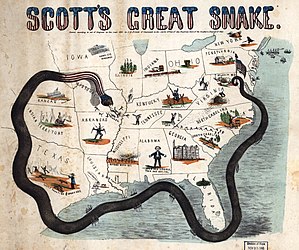
Back Anaconda-planen Danish Anakonda-Plan German Plan Anaconda Spanish Anakonda-suunnitelma Finnish Plan Anaconda French תוכנית אנקונדה HE Anakonda terv Hungarian Piano Anaconda Italian 아나콘다 계획 Korean Anakondas plāns Latvian/Lettish
This article includes a list of general references, but it lacks sufficient corresponding inline citations. (January 2023) |

The Anaconda Plan was a strategy outlined by the Union Army for suppressing the Confederacy at the beginning of the American Civil War.[1] Proposed by Union General-in-Chief Winfield Scott, the plan emphasized a Union blockade of the Southern ports and called for an advance down the Mississippi River to cut the South in two. Because the blockade would be rather passive, it was widely derided by a vociferous faction of Union generals who wanted a more vigorous prosecution of the war and likened it to the coils of an anaconda suffocating its victim. The snake image caught on, giving the proposal its popular name.
In the early days of the Civil War, Scott's proposed strategy for the war against the South had two prominent features. First, all ports in the seceding states were to be full boxed. Secondly, a strong column of perhaps 80,000 men should use the Mississippi River as a highway to thrust completely through the Confederacy. A spearhead, a relatively small amphibious force of army troops transported by boats and supported by gunboats, should advance rapidly, capturing the Confederate positions down the river in sequence. It would be followed by a more traditional army, marching behind to secure victories. The culminating battle would be for the forts below New Orleans. When they fell, the river would be in US hands from its source to its mouth, and the rebellion would be cut in two.[2]
- ^ Wolfe, B. Anaconda Plan. (2011, May 9). Retrieved from Encyclopedia Virginia Web. 17 Oct. 2015
- ^ ORA I, v. 51/1, pp. 369–370, 387
© MMXXIII Rich X Search. We shall prevail. All rights reserved. Rich X Search